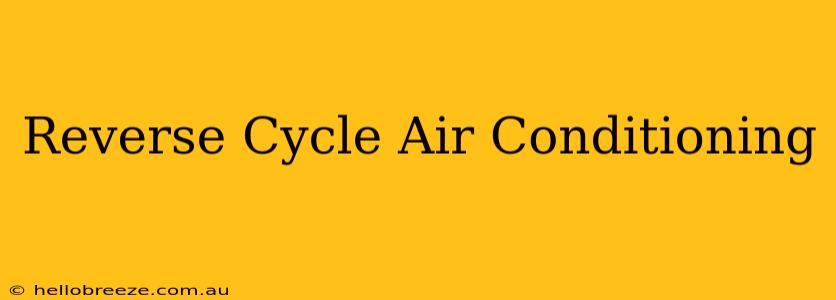Reverse cycle air conditioning, also known as heat pump air conditioning, is revolutionizing how we approach climate control. This innovative technology offers a highly efficient and versatile solution for both heating and cooling your home, providing year-round comfort while potentially saving you money on energy bills. This comprehensive guide will explore the benefits, workings, and considerations of reverse cycle air conditioning systems.
How Does Reverse Cycle Air Conditioning Work?
Unlike traditional heating and cooling systems that rely on separate units, reverse cycle systems cleverly utilize a single unit to perform both functions. The magic lies in a reversible refrigerant cycle.
-
Cooling Mode: In summer, the system absorbs heat from inside your home and transfers it outside, leaving your home cool and comfortable.
-
Heating Mode: During winter, the process reverses. The system extracts heat from the outside air (even on relatively cold days) and pumps it into your home, providing effective and efficient warmth.
This ingenious design offers significant advantages over conventional systems.
Understanding the Refrigerant Cycle
The heart of the system is the refrigerant, a special fluid that changes state (from liquid to gas and vice-versa) as it absorbs and releases heat. This change of state allows for the efficient transfer of heat, creating either a cooling or heating effect depending on the cycle's direction.
Benefits of Reverse Cycle Air Conditioning
Reverse cycle air conditioners offer a multitude of benefits:
-
Energy Efficiency: These systems are significantly more energy-efficient than separate heating and cooling systems, often achieving energy efficiency ratings (EERs and COPs) far exceeding traditional options. This translates to lower energy bills and a smaller carbon footprint.
-
Cost-Effective: While the initial investment might be slightly higher than separate systems, the long-term savings on energy costs often make it a more cost-effective solution over the system's lifespan.
-
Year-Round Comfort: Enjoy consistent comfort throughout the year, switching seamlessly between heating and cooling as needed. Say goodbye to the inconvenience of separate systems and the associated maintenance headaches.
-
Quiet Operation: Modern reverse cycle systems are engineered for quiet operation, ensuring minimal disruption to your home environment.
-
Improved Air Quality: Many reverse cycle systems incorporate features like air filtration, improving the overall air quality within your home and benefiting those with allergies or respiratory sensitivities.
Choosing the Right Reverse Cycle Air Conditioning System
Selecting the right system depends on several factors:
-
Home Size: The system's capacity (measured in kW) needs to match your home's size and insulation levels. An undersized unit will struggle to keep up, while an oversized unit can be inefficient and cycle on and off too frequently.
-
Climate: Your local climate will influence the system's requirements. In regions with extreme temperatures, you may need a more powerful system with specialized features.
-
Budget: Consider both the initial purchase price and ongoing running costs when comparing different models and brands.
-
Features: Explore features such as zoning (controlling temperature in different areas of your home), smart home integration, and air purification capabilities.
Maintenance and Longevity
Proper maintenance is crucial for extending the lifespan and efficiency of your reverse cycle air conditioning system. Regular servicing by a qualified technician will ensure optimal performance and help prevent costly repairs. This typically includes:
-
Air filter cleaning or replacement: Regularly clean or replace air filters to maintain optimal airflow and efficiency.
-
Coil cleaning: Professional cleaning of the evaporator and condenser coils removes dust and debris, improving heat transfer and efficiency.
-
Refrigerant checks: Regular checks ensure the system has the correct refrigerant levels for optimal performance.
Reverse cycle air conditioning provides a compelling solution for modern homes seeking year-round comfort and energy efficiency. By carefully considering the factors discussed above, you can choose a system that perfectly suits your needs and delivers years of reliable performance.

